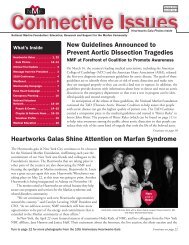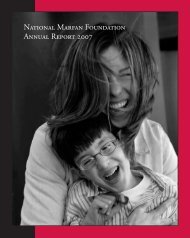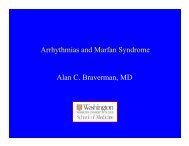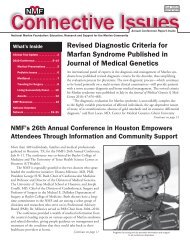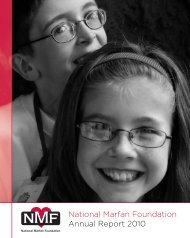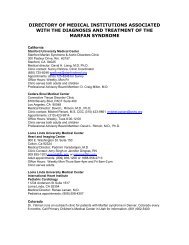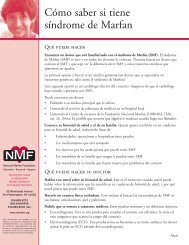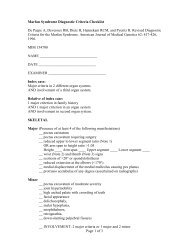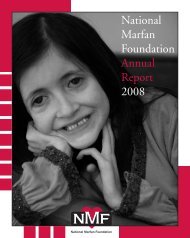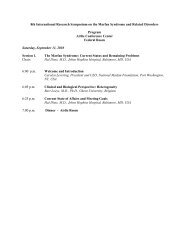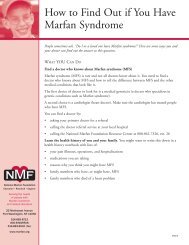Marvin Does Not Mean Martian - National Marfan Foundation
Marvin Does Not Mean Martian - National Marfan Foundation
Marvin Does Not Mean Martian - National Marfan Foundation
Create successful ePaper yourself
Turn your PDF publications into a flip-book with our unique Google optimized e-Paper software.
<strong>Not</strong><br />
<strong>Marfan</strong> <strong>Does</strong> <strong>Mean</strong> <strong>Martian</strong><br />
By Elias Clark Turner
22 Manhasset Avenue<br />
Port Washington, NY 11050<br />
800-8-MARFAN<br />
www.marfan.org<br />
The <strong>National</strong> <strong>Marfan</strong> <strong>Foundation</strong>, founded in 1981, is a non-profit voluntary health<br />
organization dedicated to saving lives and improving the quality of life for individuals and<br />
families affected by <strong>Marfan</strong> syndrome and related disorders. The <strong>Foundation</strong> accomplishes<br />
these goals through:<br />
Research<br />
Promoting research to improve diagnosis and treatment and to find a cure through:<br />
• A grant and fellowship program for all <strong>Marfan</strong>-related disciplines<br />
• Advocacy for federal funding and policies that support the NMF mission<br />
• Medical and Scientific Symposia<br />
• Partnerships with government agencies and other voluntary health organizations<br />
Education<br />
Providing accurate and up-to-date information about <strong>Marfan</strong> syndrome and related disorders to:<br />
• Patients and families<br />
• Health care professionals<br />
• The general public<br />
Support Services<br />
Helping individuals and families with <strong>Marfan</strong> syndrome and related disorders through:<br />
• The NMF Information and Resource Center, which provides access to personalized<br />
service through a toll free information line, 1-800-8-MARFAN, and email<br />
• The <strong>National</strong> Volunteer Network, consisting of Chapters, Network Groups, Support<br />
Groups, and individual volunteers, which carries out the NMF mission at the local level<br />
• The NMF Annual Conference, newsletter and website
<strong>Marfan</strong> <strong>Does</strong> <strong>Not</strong> <strong>Mean</strong> <strong>Martian</strong><br />
By Elias Clark Turner<br />
Illustrations by Alexandra Dubow
This book is dedicated to Dr. Hal Dietz with gratitude<br />
for all he does each day to improve the lives<br />
of people with <strong>Marfan</strong> Syndrome.
The day that <strong>Marvin</strong> moved into the neighborhood,<br />
his family arrived in a silver automobile with doors that opened like wings spreading out and upwards.<br />
First <strong>Marvin</strong>’s dad got out of the car, stretched, and I noticed right off the bat what a tall guy he was.<br />
His arms looked longer than normal and I wondered how he had ever fit into his car. He was thin as a<br />
pencil and his glasses were thick with big black rims. He didn’t stand up straight which kind of made<br />
him look like a question mark.<br />
Then <strong>Marvin</strong>’s mom got out. She looked absolutely normal—about as tall as most of the grown-ups<br />
I knew. She looked around and smiled, saw me watching, and she waved.<br />
Next <strong>Marvin</strong> stepped out. The first thing I noticed was his chest. It stuck out strangely in a point from<br />
the middle of his shirt. Either that or he was carrying something pointy in his undershirt. He also had<br />
these really long skinny arms. But in most other ways he resembled his father, except that he looked to<br />
be about my age.<br />
Looking at him standing next to his dad, I wondered if everyone in this family had always looked that<br />
way…. And then I saw him and his dad give each other a “thumbs up” about the new house. I had never<br />
seen thumbs like those before.
2<br />
Before heading into his new house, the boy looked around. But unlike his mom, when he<br />
saw me, instead of waving, he looked away and quickly walked up the path. I hoped he was<br />
just shy. But he sure seemed strange. I seriously started wondering whether a family of<br />
<strong>Martian</strong>s had just moved in across the street.<br />
That was on Sunday.
On Monday, the first day of school for the new year, my mom drove me to Thomas Edison Elementary<br />
where I was to become a member of Miss Barbasol’s fourth grade class. Her last year’s class had really<br />
loved her. I was excited she would be my teacher.<br />
As I closed the car door, I noticed the same silver car I had seen the day before sitting in the parking<br />
lot. It looked like that the strange kid I had seen yesterday was going to be attending my school.<br />
My mom walked me to my classroom where Miss Barbasol was standing outside greeting her new<br />
pupils and talking to their parents. I noticed the new kid’s parents ahead of us in line. They seemed to<br />
be talking with the teacher for a very long time. When we got to the door of the classroom, I said hello<br />
to Miss Barbasol and hugged my mom good-bye. I went inside and found that there were name cards<br />
on all of the desks. I went around until I located my correct place at a table. My table partner was going<br />
to be someone named <strong>Marvin</strong>. All I could think to myself was “<strong>Marvin</strong> the <strong>Martian</strong>... like the cartoon.”<br />
Then it occurred to me who <strong>Marvin</strong> might be.<br />
Our table was in the front of the classroom just a couple feet from the whiteboard. I liked sitting<br />
close to the front because I could always see what the teacher was doing. The first bell rang and sure<br />
enough, the kid I saw yesterday walked in. He came over and sat down at my table. He kind of<br />
slumped over and I could clearly see the low end of his chest poking out under his shirt. It looked like<br />
it was an uncomfortable way to sit. I figured he might be sitting that way so no one would notice but<br />
it was kind of obvious. Now I saw he was wearing glasses.<br />
3
4<br />
“I have to sit close to the board,” the boy kind of mumbled. It helps me not get headaches.”<br />
“Wow,” I thought. This guy has it hard.<br />
I felt a little worried but I pushed past it and introduced myself to my table partner.<br />
“I’m Joe Smith,” I said.<br />
He quietly replied, “My name is <strong>Marvin</strong> McGilligan. My family just moved into town.”<br />
“I saw you arrive yesterday. I live across the street from you. Your dad has a really cool car. Looks like a<br />
spaceship. What kind of car is it?” I asked.<br />
<strong>Marvin</strong> sat up a little straighter and said “Yeah, I think it’s cool, too. It’s called a Delorean. I like how<br />
the doors lift up like wings. My dad works for the company that built it. They give him one to drive<br />
around because he is in advertising.”<br />
“That’s awesome!” I blurted. “My dad’s a contractor. He specializes in kitchens and bathrooms.” Then<br />
I realized how funny that sounded. <strong>Marvin</strong> just smiled.<br />
Just then, the second bell rang with a loud buzz and Miss Barbasol entered the classroom and shut the<br />
door. She came up front and introduced herself, then announced we would go around the classroom<br />
and each of us would give our names and say something we did over the summer.
My friend Jimmy talked about how he went to a YMCA day camp and<br />
learned how to swim. Jeanine Focaccio told<br />
about taking horseback riding lessons and<br />
that she had even had tried jumping<br />
her horse once. That was cool. I could<br />
tell some of the girls were jealous.<br />
Sam had gone with his family to<br />
Chile to go skiing which everybody<br />
thought was funny because it’s so<br />
hot in the summer.<br />
But he was skiing<br />
in a country called<br />
Chile so it kind of made<br />
sense.<br />
I talked about how my<br />
friends had taken me down to the<br />
skate park over the summer and taught me how to Ollie on a<br />
skateboard.<br />
5
6<br />
<strong>Marvin</strong> listened to all of these adventures with a sad look on his face. When it got to his turn to share, he<br />
said he had taken a computer game class—which I thought was cool— but it did not get nearly as many<br />
wows as skiing in chilly Chile. I wondered if he hadn’t had any big adventures because of a problem with<br />
his chest.
Eric talked, then Suzy, then eventually everybody in the room had given their report and it was time to<br />
go out to the field to have P.E. Miss Barbasol announced with enthusiasm that today we were going to<br />
play Dodge Ball. <strong>Marvin</strong> looked worried. Somehow I got the feeling that Dodge Ball was not his favorite<br />
game. We all got up, pushed in our chairs, and made our way to the door.<br />
I was almost out the door when I noticed that <strong>Marvin</strong> had hung back and was talking quietly with Miss<br />
Barbasol. She put a sympathetic hand on his shoulder and told him in a hushed voice that it was okay<br />
for him to go to the library while the rest of the class went outside. He seemed relieved but still sad. He<br />
took a hall pass from our teacher and walked slowly off toward the library. Maybe he was used to this.<br />
When we got out to the field, Miss Barbasol was met by our school nurse, Mrs. Atkins. She asked us<br />
each to grab a bucket chair from her stack and to sit down quietly facing her. “Boys and girls,” she said,<br />
“you have a new student in your class this year. His name is <strong>Marvin</strong> and he is unable to participate in<br />
our P.E. activities this year because he has a medical condition that makes it easier for him to get hurt.<br />
It is called <strong>Marfan</strong> Syndrome, and basically it means that <strong>Marvin</strong>’s body is not as strong as yours and<br />
mine. <strong>Marfan</strong> syndrome is a disorder of the connective tissue. Connective tissue holds all parts of the<br />
body together and helps control how the body grows. Because connective tissue is found throughout<br />
the body, <strong>Marfan</strong> features can occur in many different body systems, including the heart, blood vessels,<br />
bones, joints, and eyes. Sometimes, the lungs and skin are also affected.<br />
7
chest bone that curves<br />
inward or outward<br />
8<br />
long,<br />
double-jointed<br />
fingers<br />
flat feet<br />
tall, thin stature<br />
“People who have <strong>Marfan</strong> syndrome have to follow special physical<br />
activity guidelines. They are not supposed to play competitive sports such<br />
as basketball and football because it puts too much stress on<br />
the aorta, the main blood vessel that carries blood from the<br />
heart. Sports and other physical activity can also cause eye<br />
problems for people who have <strong>Marfan</strong> syndrome.<br />
nearsightedness<br />
curvature of<br />
the spine<br />
disproportionately<br />
long arms<br />
“In every other way, <strong>Marvin</strong> is just like us. He looks different<br />
than we do. But you must try to look past this and<br />
get to know <strong>Marvin</strong> for who he is.<br />
“Now, none of you are to tease him or leave him out of fun<br />
things because of it. His problem is inherited. His father has this problem,<br />
too. <strong>Marvin</strong> did not ask to be born with a genetic disorder and<br />
he wants to be treated like all of you. So please go out<br />
of your way to include <strong>Marvin</strong> in your activities and<br />
make him feel welcome.”<br />
unusually long<br />
lower half of the body<br />
Jimmy raised his hand. “Can’t he just go to the doctor and get medicine for it?”<br />
he asked. Miss Barbasol answered that <strong>Marfan</strong> syndrome is a genetic disorder<br />
and there is no cure yet.
“<strong>Marvin</strong> can take medicine to protect his aorta which is connected to his heart, and he can take medicine<br />
to stop pain when he gets hurt, but there is no medicine that can take his problem away.”<br />
Everyone was quiet. Jeanine Focaccio sniffled. She whispered to Nancy Shoemaker, “That’s really sad.<br />
I guess he can’t ride horses.”<br />
“Or ride a bike,” added Nancy.<br />
“What CAN he do,” I asked out loud?<br />
“<strong>Marvin</strong> likes doing other activities like building Legos, playing computer and video games, reading, and<br />
I hear he has some unusual pets,“ Miss Barbasol explained.<br />
“It sounds like playing at <strong>Marvin</strong>’s house would be really fun,” said Sam. “I only have one good Lego<br />
kit. I bet he has more. And my mom won’t let me have any pets at all.”<br />
“Why don’t you invite him to play at your house sometime, Sam, and maybe you will find out just how<br />
fun it is to play at his house!” suggested our<br />
teacher.<br />
9
10<br />
After the discussion ended, Mrs. Atkins complimented us on our listening and our questions and she<br />
collected our buckets. Then Miss Barbasol told us that we still had time to play a short game of Dodge<br />
Ball, so we split into teams and moved over to the blacktop. I had a lot of fun, but I kept thinking about<br />
<strong>Marvin</strong> and felt sorry for him. I wished he could be having fun, too. I decided I would invite him over to<br />
our house after school.<br />
When P.E. ended, we had Math, then Library. After Library, it was time for lunch. My mom had packed<br />
me an extra-special lunch that day- a submarine ham and cheese sandwich and a bag of fresh pretzels.<br />
I even had two juice packs. I sat down by <strong>Marvin</strong>, hoping to invite him over after school. Some kids had<br />
bought the school lunch. It looked pretty bad.<br />
But <strong>Marvin</strong> and I had homemade lunch in common He was slowly eating a PB&J on whole wheat bread.<br />
Someone at his house was a health nut. He had carrot sticks. Poor <strong>Marvin</strong>. Carrot sticks. Now I really<br />
felt sorry for him and I offered him some of my pretzels and my extra juice. His eyes lit up and he gladly<br />
accepted them.<br />
“<strong>Marvin</strong>, we just got this new trampoline in our backyard. It’s not that big but it’s lots of fun. You wanna<br />
come over and try it out after school?” I asked.<br />
“Well, I would but I am not allowed to play on trampolines because I might twist my ankles,” he<br />
explained, but can we do something else?”
12<br />
“Sure,” I said. Then I had to stop and think. What COULD <strong>Marvin</strong> do at my house? “We have this big<br />
tin of Lincoln Logs. Maybe we could build something with them.”<br />
“Sure, that sounds like fun. I love building things. But I have to check with my mom.”<br />
After school at pick up, I saw <strong>Marvin</strong>’s silver car pull up. He went over but before getting in, leaned in<br />
and asked his mom if he could come over to play at my house that day. Then he came back over to me<br />
looking disappointed and said, “I can’t come over. I have to go get an echocardiogram. But can I come<br />
over tomorrow instead?”<br />
“Sure,” I answered. “What’s an echocardiogram?”<br />
So <strong>Marvin</strong> took a deep breath and explained. He said it was a test where the doctor took pictures of<br />
his heart to see if the tubes leading up to his heart and away from his heart were the right size.” I was<br />
confused.<br />
“How do they do that without cutting open your chest!” I blurted. “Is that why you have that big point<br />
there?” It was a slip of the tongue.<br />
<strong>Marvin</strong> laughed and said, “No, Silly. That’s just the way the bone in my chest grows. And the doctor’s<br />
assistant takes the pictures with a special machine called ultrasound that doesn’t look like a camera at all.”
I suddenly remembered when<br />
my mom got an ultrasound<br />
when she was pregnant with<br />
my little brother. I got to<br />
watch. Now I understood. “So<br />
they cover you in slimy goop<br />
and stick wires on you to take<br />
the pictures?” I asked.<br />
“Yep. Then they slide this<br />
thing that looks like a microphone<br />
around in the goop and<br />
they click it to take the pictures<br />
on a computer screen. I can<br />
watch that or watch a movie<br />
while I am being slimed.”<br />
“That sounds like it tickles.”<br />
“It sure does.”<br />
13
14<br />
“<strong>Marvin</strong>,” called his mom. “C’mon, Honey. We don’t want to be late.”<br />
“I gotta go, Joe. See you tomorrow,” he said happily.<br />
“Bye, <strong>Marvin</strong>. Have a nice sliming,” I called after him.<br />
On Tuesday, <strong>Marvin</strong> whistled as he came into class. He sat down at our table and said, “Mom gave me<br />
permission to come over and play today. Is it okay with your mom?”<br />
“Sure is,” I said. “She can pick us up after school. Maybe we can stop for frozen yogurt on the way<br />
home.”<br />
“Sounds delicious,” he said. “I want to get mine with three toppings. My mom only lets me have granola.”<br />
“Okay, then let’s load up on sugar. So how’d your echocardiogram go?” I asked.<br />
“Went fine, but the doctor put me on a new medication. I have to take a pill everyday. She said it might<br />
help me get stronger so I could do more someday. But it’s still experimental. I am becoming a science<br />
project.”<br />
“Maybe we can enter you in the school science fair this year,” I joked.<br />
“<strong>Not</strong> a bad idea,” said <strong>Marvin</strong>. “They are going to study me at Johns Hopkins University so we might<br />
as well.”
“Cool!” I said. “Why is it called <strong>Marfan</strong>,<br />
anyway?”<br />
“It was discovered by a doctor in France<br />
in 1896. His name was Antoine <strong>Marfan</strong>.<br />
He noticed that one of his patients, a<br />
five year old girl, had very long arms,<br />
fingers, toes, and skinny legs, and these<br />
things were all discovered to be part of<br />
a problem that did not get explained<br />
until 1991! Doctors eventually figured<br />
out that there were other problems that<br />
went along with the long arms and fingers<br />
and toes… stuff like a curved<br />
spine, and eye lenses that can break<br />
loose, and leaky heart valves, and really<br />
weak joints that could twist and sprain.<br />
The most dangerous thing is that if<br />
your aorta gets too big it can explode.”<br />
15
16<br />
“It sounds horrible. <strong>Does</strong> this mean you a walking pipe bomb, <strong>Marvin</strong>?”<br />
“Nope. My aorta is not that bad. And I have that new medicine. Plus they keep a pretty good watch over<br />
me. There is even surgery people with <strong>Marfan</strong> get to prevent their aortas from exploding. My grandma<br />
already had that operation and she is fine now. And besides, no two people in a family have <strong>Marfan</strong> in<br />
all the same places. We are each one of us pretty unique. My dad has a curved spine but I don’t! “<br />
“Phew!” I said, relieved that at least <strong>Marvin</strong> did not have that problem. “So your grandma even has it?<br />
How did you get <strong>Marfan</strong>, exactly?”<br />
“It’s inherited. It’s in our genes in my family. It started on my dad’s side of the family and his mom’s<br />
mom had it first. No one knows how the first person gets it though.<br />
“What do you mean it’s in your genes?” I asked.<br />
“Well it’s in our chromosomes and those are in our genes,” he tried to explain. I must have looked<br />
pretty mixed up because he continued, “in 1991, a doctor was able to trace the problem to a chromosome.<br />
Do you know what a chromosome is?” I didn’t .<br />
“Well it’s a collection of our DNA. We have 46 chromosomes in each of the cells in our bodies.<br />
Each chromosome has many genes. And one of the genes in the 15th chromosome of people with my<br />
disorder has a bad mutation. My dad has this mutation, too. He passed it along to me. My mom doesn’t
have it at all. But just because my dad has it, there was a 50 percent chance I might get it too, and well.<br />
that’s the way the cookie crumbled.”<br />
“What a tough break for you, “ I said. But on the bright side, it kinda sounds like an X-Men movie.”<br />
Maybe you have super powers you have never discovered!”<br />
“ Well, I have tried to move things with my mind but it hasn’t worked yet. But I think I might be pretty<br />
good at music. I can figure things out on piano by<br />
ear. My doctor said a lot of people with <strong>Marfan</strong> turn<br />
out to be musicians and artists. Some of<br />
them even get famous like this guy from<br />
Broadway named Jonathon Larson who<br />
made a musical called “Rent.”<br />
“We’re still young,” I said. “Maybe you’ll find<br />
your superpower by the end of sixth grade.”<br />
“Yeah, if I practice piano, maybe,” I shrugged.<br />
“<strong>Does</strong> your brother have <strong>Marfan</strong> Syndrome<br />
too,” I asked <strong>Marvin</strong>?<br />
17
18<br />
“Nope,” he replied. “He got a better cookie. He<br />
doesn’t have to go to the doctor and take pills or<br />
anything. And he is even learning to ride a bike<br />
which makes me pretty annoyed. I mean he is only<br />
five and he gets to do everything— even learn to<br />
play soccer. I can’t do that because a ball might hit<br />
me in the head and mess up my eye lenses. It’s<br />
amazing where connective tissue is. But my dad<br />
says he is going to teach me to sail and to play golf<br />
next summer because those are two sports people<br />
with <strong>Marfan</strong> CAN do!”
“Okay, now I am jealous,” I answered. “My dad doesn’t know how to sail<br />
and he is usually too tired to do sports on the week-end. I think it’s<br />
because he is building stuff all week and he has to get up really<br />
early every day. Can I come sailing with you sometime?”<br />
<strong>Marvin</strong> laughed. “I’ll tell my dad and we can invite you. I<br />
think we’re going to get a boat next summer. So… what did<br />
you bring for lunch today? My mom gave me liver sausage<br />
with mayonnaise.” <strong>Marvin</strong> grimaced.<br />
“Don’t worry,” I told him. I asked my mom for a second<br />
bag of Fritos and for some insane reason, she agreed. I<br />
think maybe my dad replaced the downstairs toilet handle<br />
before breakfast and that made her really happy.<br />
“Is that what you meant when you said your dad specializes<br />
in bathrooms?” joked <strong>Marvin</strong>. We both smiled. It was going<br />
to be a fun year.<br />
19
20<br />
Glossary of Terms<br />
Aorta: The large artery that carries blood away from<br />
the heart to other parts of the body.<br />
Cell: The basic subunit of any living organism; the<br />
simplest unit that can exist as an independent living<br />
system.<br />
Chromosome: A structure found in the cell nucleus<br />
that contains the genes; chromosomes are composed of<br />
DNA and are found as pairs in each cell. Each parent<br />
contributes one chromosome to each pair, so every<br />
child gets half of his/her chromosomes from the<br />
mother and half from the father.<br />
Connective Tissue: It is the glue and scaffolding of<br />
the body that includes the substances between cells<br />
(extracellular matrix) consisting of collagen and elastic<br />
fibers.<br />
DNA, Deoxyribonucleic Acid: The substance of<br />
heredity; a large molecule that carries the genetic<br />
information necessary for all cellular functions,<br />
including the building of proteins.<br />
Echocardiogram: A painless test that uses sound<br />
waves to take pictures of the heart and blood vessels<br />
close to the heart.<br />
Genes: Tiny parts of each cell passed from parents<br />
to their children that tell the body how to grow and<br />
function.<br />
Genetic Disorder: A pathological condition caused by<br />
an absent or defective gene or by a chromosomal<br />
aberration. Also called hereditary disease, inherited<br />
disorder.<br />
Heart Valves: A part of the heart that opens and<br />
closes with each heartbeat. Our hearts have four<br />
valves that work together to help keep blood flowing<br />
through the heart and body.<br />
Inherited: When a person receives a feature from a<br />
parent through the genes. The feature can be how a<br />
person looks or, as with <strong>Marfan</strong> syndrome, can be a<br />
genetic disorder.
Joints: Where two bones are joined together to allow the<br />
bones to move. For example, elbows, knees, ankles, and<br />
shoulders are all joints in our body.<br />
<strong>Marfan</strong> Syndrome: <strong>Marfan</strong> syndrome is a genetic<br />
disorder that weakens multiple body systems, including<br />
the heart, blood vessels, bones and joints, lungs and<br />
eyes. The life-threatening part of <strong>Marfan</strong> syndrome is the<br />
weakening of the aorta, the large blood vessel from<br />
the heart. Early diagnosis and treatment are essential<br />
for maximizing life expectancy.<br />
Migraine Headaches: The most common type of<br />
vascular headache involving abnormal sensitivity<br />
of arteries in the brain to various triggers resulting<br />
in rapid changes in the artery size due to spasm<br />
(constriction). Other arteries in the brain and scalp<br />
then open (dilate), and throbbing pain is perceived<br />
in the head.<br />
Mutation: A permanent structural change in DNA<br />
that can cause a condition.<br />
Spine: The column of bone known as the vertebral<br />
column, which surrounds and protects the spinal<br />
cord. The spine can be categorized according to level<br />
of the body: i.e., cervical spine (neck), thoracic spine<br />
(upper and middle back), and lumbar spine (lower<br />
back).<br />
Ultrasound: High-frequency sound waves. Ultrasound<br />
waves can be bounced off of tissues using special<br />
devices. The echoes are then converted into a picture<br />
called a sonogram. Ultrasound imaging, referred to<br />
as ultrasonography, allows physicians and patients to<br />
get an inside view of soft tissues and body cavities,<br />
without using invasive techniques. Ultrasound is<br />
often used to examine a fetus during pregnancy.<br />
21
What Causes <strong>Marfan</strong> Syndrome?<br />
<strong>Marfan</strong> syndrome is caused by a defect (mutation) in the gene<br />
that tells the body how to make fibrillin-1, a protein that is an<br />
important part of connective tissue.<br />
This defect results in an increase in a protein called transforming<br />
growth factor beta, or TGFß. The increase of TGFß causes problems<br />
in tissue throughout the body, which create the different <strong>Marfan</strong><br />
syndrome features and cause medical problems for people with<br />
<strong>Marfan</strong> syndrome.<br />
People can inherit <strong>Marfan</strong> syndrome, meaning that they get the<br />
mutation from a parent who has the disorder. This is the case in<br />
about 3 out of 4 people with <strong>Marfan</strong> syndrome. Other people have<br />
a spontaneous mutation, meaning that they are the first in their<br />
family to have <strong>Marfan</strong> syndrome. People with <strong>Marfan</strong> syndrome<br />
have a 50% chance of passing the mutation on each time they<br />
have a child.<br />
People are born with <strong>Marfan</strong> syndrome but may not notice any<br />
features until later in life. <strong>Marfan</strong> syndrome features can appear<br />
at any age, including in infants and young children. They may<br />
get worse as people age.<br />
22<br />
<strong>Marfan</strong> Syndrome Features<br />
What body systems are affected?<br />
Heart and Blood Vessels<br />
(Cardiovascular system)<br />
• Enlarged or bulging<br />
aorta, the main blood<br />
vessel that carries<br />
blood from the heart<br />
(aortic dilation or<br />
aneurysm)<br />
• Separation of the layers<br />
of the aorta that can<br />
cause it to tear<br />
(aortic dissection)<br />
• “Floppy” mitral valve<br />
(mitral valve prolapse<br />
or MVP)<br />
Bones and Joints<br />
(Skeletal system)<br />
• Long arms and legs<br />
• Tall and thin body type<br />
• Curvature of the spine<br />
(scoliosis or kyphosis)<br />
• Chest sinks in<br />
(pectus excavatum)<br />
or sticks out/<br />
pidgeon chest<br />
(pectus carinatum)<br />
• Long, thin fingers<br />
• Flexible joints<br />
• Flat feet<br />
• Teeth that are too<br />
crowded
<strong>Marfan</strong> syndrome features occur in many different parts of<br />
the body. Some <strong>Marfan</strong> syndrome features are easy to see.<br />
Other features, such as heart problems, are hidden and<br />
need special tests to find them.<br />
Eyes<br />
(Ocular system)<br />
• Severe nearsightedness<br />
(myopia)<br />
• Dislocated lens<br />
of the eye<br />
• Detached retina<br />
• Early glaucoma<br />
• Early cataracts<br />
Other Body Systems<br />
• Stretch marks on<br />
the skin, not explained<br />
by pregnancy or<br />
weight gain<br />
• Sudden collapse<br />
of the lung<br />
(spontaneous<br />
pneumothorax)<br />
• Swelling of the<br />
sac around the<br />
spinal column<br />
(dural ectasia).<br />
This is found with<br />
CT or MRI scans<br />
of the back.<br />
Diagnosis<br />
Although scientists have determined that <strong>Marfan</strong> syndrome is<br />
caused by a defect in the fibrillin-1 gene on chromosome 15, there<br />
is no simple test that can conclusively diagnose <strong>Marfan</strong> syndrome.<br />
Therefore, diagnosis is made through a clinical evaluation.<br />
What Should You Do If You Suspect <strong>Marfan</strong> Syndrome?<br />
Find a doctor who knows about <strong>Marfan</strong> syndrome. The first choice<br />
of doctor to look for is a medical geneticist (a doctor who specializes<br />
in genetic conditions such as <strong>Marfan</strong> syndrome).<br />
A second choice is a cardiologist (heart doctor). Make sure the<br />
cardiologist has treated people who have MFS.<br />
You can find a doctor by:<br />
• Asking your primary doctor for a referral<br />
• Calling the doctor referral service at your local hospital<br />
• Calling your insurance provider<br />
• Calling the <strong>National</strong> <strong>Marfan</strong> <strong>Foundation</strong> Information<br />
Resource Center at 800-862-7326, ext. 26<br />
Many people with <strong>Marfan</strong> features (whether they have a diagnosis<br />
or not) need medical treatment and follow-up care. Make sure to<br />
talk with your doctor about the care that is right for you.<br />
23
Elias Turner is a student at San Dieguito High School Academy in Encinitas,<br />
California. This book was written as a project for his biology class during freshman<br />
year. He was diagnosed with <strong>Marfan</strong> syndrome in preschool. His mother, uncle,<br />
and grandmother also have <strong>Marfan</strong> syndrome. He is grateful to the <strong>National</strong><br />
<strong>Marfan</strong> <strong>Foundation</strong> for their advocacy on behalf of all young people living with<br />
<strong>Marfan</strong> syndrome seeking ways to create positive, meaningful and healthy lives.




